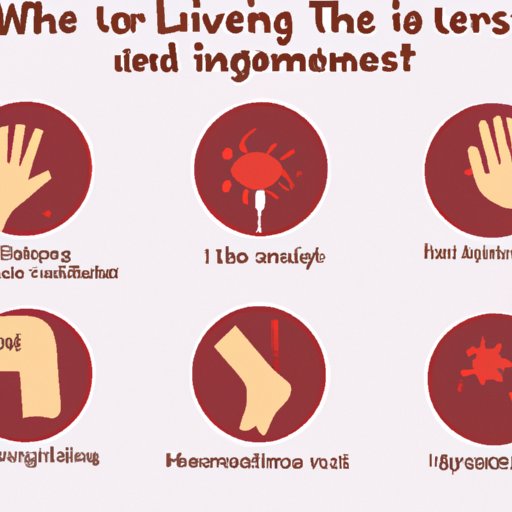
Introduction
Blood infections, also known as bloodstream infections, are a serious health concern that can cause severe complications and even lead to death if left untreated. Bloodstream infections occur when bacteria, viruses, fungi, or other pathogens enter the bloodstream, leading to an overwhelming immune response and inflammation. In this article, we will explore how blood infections occur, the risk factors, and what signs to look out for. We will also discuss tips and advice from healthcare professionals on how to prevent and treat these infections.
Causes and Risk Factors of Blood Infections: Everything You Need to Know
Blood infections occur when bacteria, viruses, fungi, or other pathogens enter the bloodstream from an infection in another part of the body or through a wound or sore. The most common sources of bloodstream infections are the urinary tract, lungs, skin, and intestines. Invasive medical procedures, such as catheterization or surgery, can also increase the risk of developing a bloodstream infection. Poor hygiene, weakened immune systems, and medical treatments that suppress the immune system also increase the risk.

5 Uncommon Ways Blood Infections Can Happen: What to Watch Out For
While urinary tract infections, pneumonia, and skin infections are the most common sources of bloodstream infections, there are a few uncommon ways that these infections can occur. Contaminated medical equipment, such as endoscopes or dialysis machines, can introduce pathogens directly into the bloodstream. Insect bites, especially from ticks, can also infect the bloodstream with bacteria and viruses. People who inject drugs or receive tattoos with unsterilized needles can also develop bloodstream infections.
To avoid these risks, it is essential to ensure that all medical equipment is properly sterilized, inspect for ticks after being in wooded or grassy areas, avoid injecting drugs, and only receive tattoos from licensed professionals who use sterile equipment. If you suspect that you might have a bloodstream infection or experience fever, chills, or fatigue, contact your healthcare provider immediately.
From IV Drugs to Dirty Scissors: The Most Common Causes of Blood Infections
Although there are uncommon ways that one can develop a bloodstream infection, the most common cause is through invasive medical procedures and poor hygiene. Catheter-associated bloodstream infections, in which a pathogen enters the bloodstream from a catheter used for draining urine, are common in hospitalized patients. Infections can also occur after surgery. Poor hygiene practices, such as not washing hands thoroughly or not disinfecting surfaces, can contribute to bloodstream infections.
Prevention of these infections can come by using proper sterilization techniques on medical equipment, practicing good hand hygiene, and choosing a health professional that follows strict hygiene practices, and washing wounds daily.
How to Prevent Blood Infections: Tips from Healthcare Professionals
The best way to prevent bloodstream infections from occurring is by taking preventative measures such as getting vaccinated or monitoring potential infections.
- Immunizations can provide protection against infections such as influenza, pneumonia, or meningitis, which can lead to bloodstream infections.
- Know and monitor your infection signs and symptoms like sudden fever, rash, chills, fatigue, or rapid breathing. Treat them immediately before they worsen and lead to a more severe infection.
- If you’re hospitalized with an IV, ask the medical professional to change the IV line or catheter dressing frequently and follow strict aseptic techniques to prevent infection from entering your bloodstream.
- Practice good hygiene, such as washing your hands before eating or touching your face, and keeping your skin clean and dry to avoid skin infections.
- Avoid close contact with people who have a contagious infection to prevent the spread of disease
Bloodstream Infections: The Symptoms and Treatment Options You Need to Know About
The symptoms of bloodstream infections include fever, chills, fatigue, and shortness of breath. If the infection spreads, it can cause sepsis, an inflammation of the body’s tissues that can cause internal organ damage and even death. Intravenous antibiotics and fluids are the most common treatment options for bloodstream infections. The healthcare provider may also remove any devices, such as catheters or IV lines, that could be contributing to the infection.
When a Simple Cut Can Lead to a Life-Threatening Blood Infection: Understanding Sepsis
Sepsis is a life-threatening medical condition that can occur if a bloodstream infection is left untreated. It can also develop from bacterial infections, pneumonia, or urinary tract infections. Sepsis occurs when the body’s immune system overreacts to an infection, leading to inflammation and organ damage. Symptoms include fever, chills, rapid heartbeat, confusion, and organ failure. Prompt medical treatment is essential to prevent complications and save lives.
Understanding Blood Poisoning: How Bacterial and Viral Infections Can Spread
Blood poisoning, also known as septicemia, is a severe medical condition that can occur when bacteria or viruses enter the bloodstream. The infection can spread rapidly and lead to sepsis or septic shock, which can be life-threatening. Bacterial infections are the most common cause of blood poisoning, and common symptoms include fever, chills, rapid heartbeat, confusion, and organ failure. To prevent blood poisoning, it’s essential to practice good hygiene measures, treat infections promptly, and follow medical recommendations to prevent the spread of infection.
Conclusion
Overall, bloodstream infections are avoidable and can be treated if caught early enough. Washing your hands, keeping wounds clean and dry, getting vaccinated, and monitoring any upcoming infections are just a few preventive measures to keep in mind. Finally, if you’re experiencing symptoms of a bloodstream infection, it’s critical that you seek medical attention immediately.




